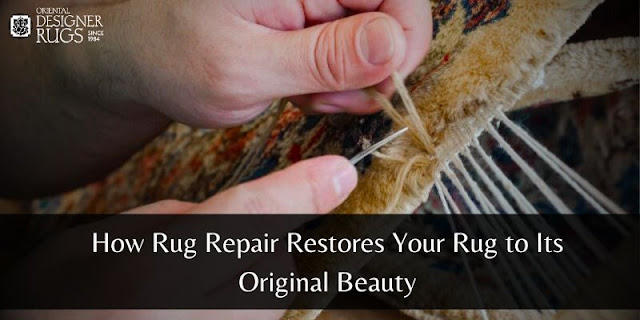How Rug Repair Restores Your Rug to Its Original Beauty
Rug repair is a meticulous process that involves restoring a rug to its original beauty or addressing specific issues such as wear and tear, damage, or discoloration. Professional rug repair specialists use various techniques to revitalize and preserve the aesthetic and structural integrity of rugs. Here's how rug repair can restore your rug:
Cleaning:
- Before any repair work begins, the rug is typically thoroughly cleaned to remove dirt, stains, and contaminants. Cleaning is an essential step in the restoration process as it provides a clean canvas for repair specialists to work on.
Evaluation of Damage:
- A skilled rug repair professional will carefully assess the extent and type of damage. This evaluation helps determine the appropriate repair techniques and materials needed for restoration.
Rebinding and Overcasting:
- The edges of rugs are prone to wear and fraying over time. Rug repair may involve rebinding or overcasting the edges to reinforce them and prevent further unraveling. This process can restore the rug's structural integrity and extend its lifespan.
Reweaving:
- For rugs with areas of missing or damaged fibers, reweaving may be employed. Skilled artisans use matching yarn or fibers to carefully reweave the missing sections, seamlessly blending them with the original pattern and colors.
Patching:
- In cases where there are irreparable holes or sections of damage, patching may be employed. Skilled craftsmen select matching materials and weave or sew patches into the damaged areas, ensuring a cohesive appearance.
Color Restoration:
- Rugs may experience color fading or discoloration over time due to exposure to sunlight or other environmental factors. Color restoration involves carefully matching and applying dyes to restore the original vibrancy of the rug.
Fringe Repair:
- Fringes are susceptible to damage, tangling, or wear. Rug repair specialists can address fringe issues by re-tying or replacing damaged fringe, restoring the rug's overall aesthetic appeal.
Stain Removal:
- Stubborn stains can be a significant concern for rug owners. Rug repair professionals have techniques and cleaning agents to address stains without causing further damage to the rug's fibers.
Blocking and Stretching:
- Over time, rugs may lose their original shape due to foot traffic or furniture placement. Rug repair specialists use blocking and stretching techniques to reshape and flatten the rug, restoring its original dimensions.
Binding:
- Binding involves reinforcing the edges of a rug with a strip of fabric or tape. This process can help prevent unraveling and adds a finished look to the rug.
Moth Damage Repair:
- Rugs can be susceptible to moth damage, which may manifest as holes or irregularities. Repair specialists can address these issues by reweaving damaged areas or employing techniques to deter moths.
Overall Restoration:
- In some cases, a comprehensive restoration process may be undertaken to address multiple issues and bring the rug back to its original condition. This could involve a combination of cleaning, repairing, and revitalizing various aspects of the rug.
Professional rug repair services often employ skilled artisans and craftspeople who specialize in different aspects of rug restoration. By combining their expertise, these professionals can bring your rug back to its original beauty or even enhance its appearance, ensuring it remains a cherished and functional piece in your home.




Comments
Post a Comment